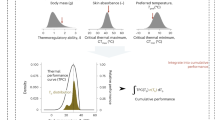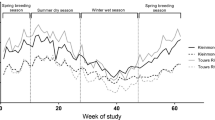Abstract
Preferred body temperatures (T sel) of ectotherms are important for ecological and evolutionary studies. In lizards, the measurement of T sel is controversial for several reasons, generally related to hypotheses addressing how T sel may evolve in the wild. Although seldom explicitly tested, evolutionary hypotheses of adaptation to local climate require that T sel meets the conditions of natural selection, which include repeatability, heritability and a link to fitness. Here, we investigated repeatability (τ, intra-class correlation coefficient) of T sel at several time-scales using four Cordylid species from heterogeneous thermal habitats. Although there was significant inter-individual variation within days (P < 0.005 in most cases), there was no significant inter-individual variation when calculated across several days (P > 0.05). Repeatability was low in all species investigated (from 0 to 0.482) when compared against other estimates of repeatability of T sel in the literature. Irrespective of how T sel was calculated, it showed inconsistent and variable temporal effects across species. Furthermore, repeatability of T sel did not change with acclimation to laboratory conditions. These data have implications for understanding the evolution of thermoregulation in these and other ectotherms.
Similar content being viewed by others
References
Angilletta MJ (2001) Thermal and physiological constraints on energy assimilation in a widespread lizard (Sceloporus undulatus). Ecology 82:3044–3056
Angilletta MJ, Werner YL (1998) Australian geckos do not display diel variation in thermoregulatory behavior. Copeia 1998:736–742
Angilletta MJ, Montgomery LG, Werner YL (1999) Temperature preference in geckos: Diel variation in juveniles and adults. Herpetologica 55:212–222
Angilletta MJ, Hill T, Robson MA (2002a) Is physiological performance optimized by behavioral thermoregulation? A case study of the eastern fence lizard, Sceloporus undulatus. J Therm Biol 27:199–204
Angilletta MJ, Niewiarowski PH, Navas CA (2002b) The evolution of thermal physiology in ectotherms. J Therm Biol 27:249–268
Angilletta MJ, Bennett AF, Guderley H, Navas CA, Seebacher F, Wilson RS (2006) Coadaptation: a unifying principle in evolutionary thermal biology. Physiol Biochem Zool 79:282–294
Arnold SJ, Peterson CR, Gladstone J (1995) Behavioral variation in natural populations. VII Maternal body temperature does not affect juvenile thermoregulation in a garter snake. Anim Behav 50:623–633
Barber BJ, Crawford EC Jr (1977) A stochastic dual-limit hypothesis for behavioral thermoregulation in lizards. Physiol Zool 50:53–60
Bauwens D, Garland T Jr, Castilla A, Van Damme R (1995) Evolution of sprint speed in lacertid lizards: morphological, physiological and behavioral covariation. Evolution 49:848–863
Beitinger TL, Fitzpatrick LC (1979) Physiological and ecological correlates of preferred temperature in fish. Am Zool 19:319–329
Bennett AF (1987) Inter-individual variability: An underutilized resource. In: Feder ME, Bennett AF, Burggren WW, Huey RB (eds) New directions in ecological physiology. Cambridge University Press, Cambridge, pp 1–8
Bennett AF (1997) Adaptation and the evolution of physiological characters. In: WH Danzler (eds) Handbook of physiology, Sect. 13: comparative physiology, Vol 1. Oxford University Press, New York, pp 3–16
Bennett AF, John-Alder H (1986) Thermal relations of some Australian skinks (Sauria: Scincidae). Copeia 1986:57–64
Berk ML, Heath JE (1975) An analysis of behavioral thermoregulation in the lizard Dipsosaurus dorsalis. J Therm Biol 1:15–22
Berteaux D, Thomas DW, Bergeron J-M, Lapierre H (1996) Repeatability of daily field metabolic rate in female Meadow Voles (Microtus pennsylvanicus). Funct Ecol 10:751–759
Boake CRB (1989) Repeatability: its role in evolutionary studies of mating behavior. Evol Ecol 3:173–182
Brown RP, Griffin S (2005) Lower selected body temperatures after food deprivation in the lizard Anolis carolinensis. J Therm Biol 30:79–83
Castilla AM, Bauwens D (1991) Thermal biology, microhabitat selection, and conservation of the insular lizard Podarcis hispanica atrata. Oecologia 85:366–374
Christian KA, Bedford GS (1995) Seasonal changes in thermoregulation by the frillneck lizard, Chlamydosaurus kingii, in tropical Australia. Ecology 76:124–132
Christian KA, Weavers BW (1996) Thermoregulation of monitor lizards in Australia: an evaluation of methods in thermal biology. Ecol Mon 66:139–157
Christian KA, Tracy CR, Porter WP (1985) Inter- and intra-individual variation in body temperature of the Galapagos land iguana. J Therm Biol 10:47–50
Cooper WE, Whiting MJ, Van Wyk JH (1997) Foraging modes of cordyliform lizards. S Afr J Zool 32:9–13
Dawson WR (1975) On the physiological significance of the preferred body temperatures of reptiles. In: Gates DM, Schmerl RB (eds) Perspectives of biophysical ecology: ecological studies. Vol 12. Springer-Verlag, New York, pp 433–473
Dohm MR (2002) Repeatability estimates do not always set an upper limit to heritability. Funct Ecol 16:273–280
Dohm MR, Mautz WJ, Looby PG, Gellert KS, Andrade JA (2001) Effects of ozone on evaporative water loss and thermoregulatory behavior of marine toads (Bufo marinus). Env Res 86:274–286
Du W-G, Yan S-J, Ji X (2000) Selected body temperature, thermal tolerance and thermal dependence of food assimilation and locomotor performance in adult blue-tailed skinks, Eumeces elegans. J Therm Biol 25:197–202
Endler JA (1986) Natural selection in the wild. Princeton University Press, Princeton
Falconer DS, Mackay TFC (1996) Introduction to quantitative genetics. Prentice Hall, Harlow
Firth BT, Belan I (1998) Daily and seasonal rhythms in selected body temperatures in the Australian lizard Tiliqua rugosa (Scincidae): field and laboratory observations. Physiol Zool 71:303–311
Gaines SD, Denny MW (1993) The largest, smallest, highest, lowest, longest, and shortest: extremes in ecology. Ecology 74:1677–1692
Garcia LV (2004) Escaping the Bonferroni iron claw in ecological studies. Oikos 105:657–663
Garland T Jr (1985) Ontogenetic and individual variation in size, shape, and speed in the Australian agamid lizard Amphibolurus nuchalis. J Zool 207:425–439
Garland T Jr, Hankins E, Huey RB (1990) Locomotor performance and social dominance in male lizards. Funct Ecol 4:243–250
Gilchrist GW (1995) Specialists and generalists in changing environments. I Fitness landscapes of thermal sensitivity. Am Nat 146:252–270
Good DS (1993) Evolution of behaviours in Drosophila melanogaster in high temperatures: genetic and environmental effects. J Insect Physiol 39:537–544
Hayes JP, Jenkins SH (1997) Individual variation in mammals. J Mamm 78:274–293
Hayes JP, Bible CA, Boone JD (1998) Repeatability of mammalian physiology: evaporative water loss and oxygen consumption of Dipodomys merriami. J Mamm 79:475–485
Helmuth B, Kingsolver JG, Carrington E (2005) Biophysics, physiological ecology and climate change: does mechanism matter?. Ann Rev Physiol 67:177–201
Hertz PE, Huey RB, Stevenson RD (1993) Evaluating temperature regulation by field-active ectotherms: the fallacy of the inappropriate question. Am Nat 142:796–818
Hoffmann AA, Sørensen JG, Loeschcke V (2003) Adaptation of Drosophila to temperature extremes: bringing together quantitative and molecular approaches. J Therm Biol 28:175–216
Huey RB (1982) Temperature, physiology and the ecology of reptiles. In: Gans C, Pough FH (eds) Biology of the Reptilia. Vol 12. Academic Press, London, pp 25–91
Huey RB, Bennett AF (1987) Phylogenetic studies of coadaptation: preferred temperature versus optimal performance temperatures of lizards. Evolution 41:1098–1115
Huey RB, Dunham AT (1987). Repeatabilility of locomotor performance in natural populations of the lizard Sceloporus merriami. Evolution 41:1116–1120
Huey RB, Kingsolver JG (1989) Evolution of thermal sensitivity of ectotherm performance. Trends Ecol Evol 4:131–135
Huey RB, Slatkin M (1976) Cost and benefits of lizard thermoregulation. Quart Rev Biol 51:363–384
Huey RB, Webster TP (1976) Thermal biology of Anolis lizards in a complex fauna: the cristatellus group on Puerto Rico. Ecology 57:985–994
Huey RB, Hertz PE, Sinervo B (2003) Behavioral drive versus behavioral inertia in evolution: a null model approach. Am Nat 161:357–366
Huey RB, Dunham AE, Overall KL, Newman RA (1990) Variation in locomotor performance in demographically known populations of the lizard Sceloporus merriami. Physiol Zool 63:845–872
Krebs CJ (1999) Ecological methodology. Addison-Wesley Educational Publishers, California
Lailvaux SP, Alexander GJ, Whiting MJ (2003) Sex-based differences and similarities in locomotor performance, thermal preferences, and escape behavior in the lizard Platysaurus intermedius wilhelmi. Physiol Biochem Zool 76:511–521
Le Galliard J-F, Le Bris M, Clobert J (2003) Timing of locomotor impairment and shift in thermal preferences during gravidity in a viviparous lizard. Funct Ecol 17:877–885
Lessells CM, Boag PT (1987) Unrepeatable repeatabilities: a common mistake. Auk 104:116–121
Licht P, Dawson WR, Shoemaker VH, Main AR (1966) Observations on the thermal relations of western Australian lizards. Copeia 1966:97–110
Littell RC, Millinken GA, Stroup WW, Wolfinger RD (1996) SAS systems for mixed models. SAS Institute, Cary, North Carolina
McNab BK (2003) Sample size and the estimation of physiological parameters in the field. Funct Ecol 17:82–86
Patapoutian A, Peier AM, Story GM, Viswanath V (2003) ThermoTRP channels and beyond: mechanisms of temperature sensation. Nature Rev Neurosci 4:529–539
Patterson JW, Davies PMC (1978) Preferred body temperature: seasonal and sexual differences in the lizard Lacerta vivipara. J Therm Biol 3:39–41
Peterson CR, Arnold SJ (1986) Individual variation in the thermoregulatory behavior of free-ranging garter snakes, Thamnophis elegans. Am Zool 26:112
Rock J, Andrews RM, Cree A (2000) Effects of reproductive condition, season and site on selected temperatures of a viviparous gecko. Physiol Biochem Zool 73:344–355
Seebacher F (2005) A review of thermoregulation and physiological performance in reptiles: what is the role of phenotypic flexibility?. J Comp Physiol B 175:453–461
Seebacher F, Franklin CE (2005) Physiological mechanisms of thermoregulation in reptiles: a review. J Comp Physiol B 175:533–541
Skinner DC (1991) Effect of intraperitoneal melatonin injections on thermoregulation in the Transvaal girdled lizard, Cordylus vittifer. J Therm Biol 16:179–184
Sievert LM, Hutchison VH (1989) Influences of season, time of day, light and sex on the thermoregulatory behavior of Crotaphytus collaris. J Therm Biol 14:159–165
Sinervo B (1990) Evolution of thermal physiology and growth rate between populations of the western fence lizard (Sceloporus occidentalis). Oecologia 83:228–237
Stevenson RD, Peterson CR, Tsuji JS (1985) The thermal dependence of locomotion, tongue flicking, digestion, and oxygen consumption in the wandering garter snake. Physiol Zool 58:46–57
Tsuji JS, Huey RB, van Berkum FH, Garland T Jr, Shaw RG (1989) Locomotor performance of hatchling fence lizards (Sceloporus occidentalis): quantitative genetics and morphometric correlates. Evol Ecol 3:240–252
van Berkum FH, Huey RB, Tsuji JS, Garland T Jr (1989) Repeatability of individual differences in locomotor performance and body size during early ontogeny of the lizard Sceloporus occidentalis. Funct Ecol 3:97–105
Van Damme R, Bauwens D, Verheyen RF (1990) Evolutionary rigidity of thermal physiology: the case of the cool temperate lizard Lacerta vivipara. Oikos 57:61–67
Wheeler PE (1986) Thermal acclimation of metabolism and preferred body temperature in lizards. J␣Therm Biol 11:161–166
Wilhoft DC, Anderson JD (1960) Effect of acclimation on the preferred body temperature of the lizard, Sceloporus occidentalis. Science 131:610–611
Wills CA, Beaupre SJ (2000) An application of randomization for detecting evidence of thermoregulation in timber rattlesnakes (Crotalus horridus) from Northwest Arkansas. Physiol Biochem Zool 73:325–334
Zhang Y-P, Ji X (2004) The thermal dependence of food assimilation and locomotor performance in southern grass lizards, Takydromus sexlineatus (Lacertidae). J Therm Biol 29:45–53
Acknowledgements
We thank M. Esterhuyse, R.M. Trullas and various members of the Vertebrate Functional Biology group at the University of Stellenbosch for field assistance. Sue Jackson and Ray Huey as well as three anonymous reviewers provided valuable comments on an earlier version of the manuscript. Research was conducted under permit (#196/2004) from Cape Nature Conservation (South Africa) and was approved by the Institutional Animal Care and Use Committee at Drexel University and the Sub-committee B of the Research Committee at the University of Stellenbosch (Protocol #02669-01 and #15986). Financial support was provided by The Leatherback Trust and the Betz Chair of Environmental Science at Drexel University. JST was funded by Grant FA2004032000006 from the National Research Foundation.
Author information
Authors and Affiliations
Corresponding author
Rights and permissions
About this article
Cite this article
Clusella Trullas, S., Terblanche, J.S., van Wyk, J.H. et al. Low repeatability of preferred body temperature in four species of Cordylid lizards: Temporal variation and implications for adaptive significance. Evol Ecol 21, 63–79 (2007). https://doi.org/10.1007/s10682-006-9124-x
Published:
Issue Date:
DOI: https://doi.org/10.1007/s10682-006-9124-x




